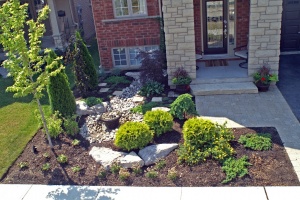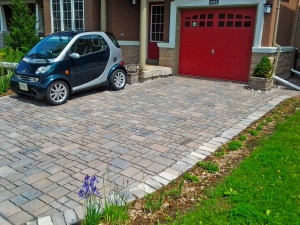LID opportunities on residential land
Overview[edit]
On residential lands, hard surfaces such as roofs, patios, walkways and driveways can all be targeted to collect, treat, and infiltrate runoff. The practices you choose will vary depending on neighbourhood and site constraints and landscape ideals.
Landscape alternatives[edit]
Landscape alternatives capture rainfall in leafy green foliage, with the intention of increasing infiltration, filtration, and evapotranspiration of rainfall and runoff. Well-designed landscape alternatives require little maintenance and less irrigation after establishment than turf.
Healthy, uncompacted soil provides important stormwater management functions including infiltration and temporary storage of runoff, filtration of suspended sediments, adsorption and biological decomposition of pollutants and moderation of peak stream flows and temperatures. Healthy soils also support vigorous plant growth that intercepts rainfall, returning much of it to the atmosphere through evaporation and transpiration. Standard construction practices involve removing and stockpiling topsoil during clearing and grading, compacting subsoil and replacing a shallow layer of the stockpiled site topsoil, typically 10 to 15 cm deep, on top of the compacted subsoil at the end of construction. This typically produces a poor quality growing environment that requires excessive irrigation and fertilizer applications to establish plantings, raising the potential for these pervious areas to be a source of contaminated runoff during storm events.
A simple, inexpensive lot level stormwater management practice is the application of a deeper than standard layer of high quality topsoil in pervious landscaped areas, especially those that will receive roof runoff from downspouts. This practice is of particular interest because at the end of construction work there is always a surplus of topsoil from clearing and grading that otherwise must be hauled away at a cost to the developer. The practice of adjusting grading of landscaped areas, scarifying the subsoil to reverse compaction, and applying a deeper layer of organic topsoil has the potential to reduce costs associated with having to haul it away. It also has the potential to absorb, infiltrate and evapotranspire a greater amount of stormwater than standard landscaping practices, thereby providing runoff reduction benefits. Amending poor quality topsoil or compacted subsoil with compost increases moisture and pollutant retention capacity and permeability, and reduces bulk density and erosivity. In addition, this practice also provides a better growing environment for grass, shrub and tree plantings, requiring less irrigation and fertilizer to become established than plantings in more shallow, unimproved topsoil overlying compacted subsoil.
Landscape alternatives allow homeowners to customize their property’s landscape to their liking. A guiding principle when designing landscape alternatives is “the right plant for the right place”. Using both native and non-native plants is acceptable as long as the non-native plants are not invasive and do not require frequent watering. Various landscape alternatives are available, including:
Xeriscaping[edit]
Xeriscaping refers to landscaping, plantings and gardening practices that reduce or eliminate the need for watering by selecting plants based on their ability to survive with little water. Synonymous with water conservation, xeriscaping was originally promoted in areas with perennial water shortages. Additional benefits include reducing water bills, lowering maintenance requirements, and better plant survival rates and aesthetics during drought periods. Xeriscaping can be used on a lot-by-lot basis or in combination with larger residential LID programs. The Region of Peel’s Fusion Landscaping® program is an example of this.
Tree Clusters[edit]
Tree clusters are another residential landscape alternative. Tree clusters improve water quality, generate organic soils, absorb greenhouse gases, and provide shade for homes. Tree clusters require larger lot sizes, preferably with no overhead wires. They can be planted as standalone features or as part of a larger residential LID landscape.
Topsoil[edit]
STEP have a guide to amending and improving topsoil to improve the water retention capacity and promote healthy vegetation. I can be found here on our main website.
Materials[edit]
Rain gardens[edit]

Permeable Pavements[edit]
Focus on aesthetic appeal when marketing permeable pavers to homeowners. They come in a variety of colours and shapes, and can be laid out to form patterns or designs that enhance the aesthetics of residential properties.
Soakaways and Infiltration Trenches[edit]
Soakaways, also known as infiltration chambers or dry wells, are excavations in native soil that are filled with clean granular aggregates. Soakaways are typically designed with a perforated pipe inlet from a relatively clean water source, such as a roof tops or pedestrian area.
When possible, install soakaways in areas where native soils allow for infiltration. If poorly draining soils are present, an underdrain can be installed to remove standing water.
Where lot size is a constraint, a linear variation known as infiltration trenches can be used. This technique may be appropriate for sites where retrofit space is limited to long strips between buildings or along property lines.
Rainwater Harvesting[edit]
Rainwater harvesting is the process of collecting and storing rainwater for future use. Harvested water can be used for a variety of non-potable indoor and outdoor uses with minimal treatment. Rainwater harvesting provides an easy, low-cost option for homeowners to reduce the volume of runoff conveyed from their properties to the municipal storm sewer system.
Rainwater harvesting systems[edit]
Rainwater harvesting systems collect rainwater from roof runoff and store it until it is needed. These systems are often used for irrigation, but with additional equipment and proper treatment, this water can be used for flushing toilets. By using rainwater around the home, residents can reduce their water bills while also reducing the amount of stormwater runoff entering the storm sewer system. Rainwater storage tanks come in a variety of dimensions and shapes to accommodate both the size and desired aesthetics of residential properties. Fro four season use, they are usually placed in the basement or buried underground.
Rain Barrels[edit]
While they provide similar functions to rainwater harvesting systems, rain barrels have limited storage space and seasonal function. They are installed at the outlet of downspouts and intercept water draining down roofs for later use in irrigation. Rain barrels come in a variety of shapes, sizes and styles. Residents can choose a style of rain barrel best suited to their home and personal tastes.

